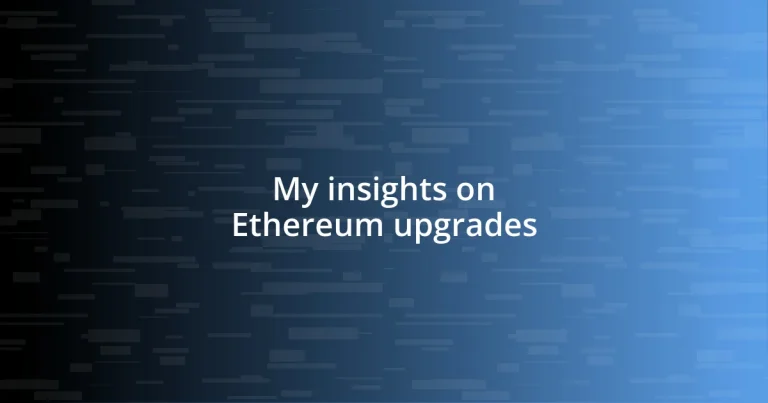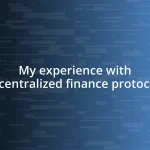Key takeaways:
- Ethereum enables decentralized applications and smart contracts, empowering users by eliminating intermediaries.
- Major upgrades, including Eth 2.0 and EIP-1559, have significantly improved functionality, security, and user experience through innovations like proof-of-stake and predictable gas fees.
- Future advancements such as Layer 2 solutions and sharding promise to enhance scalability and interoperability, supporting a broader range of decentralized applications.
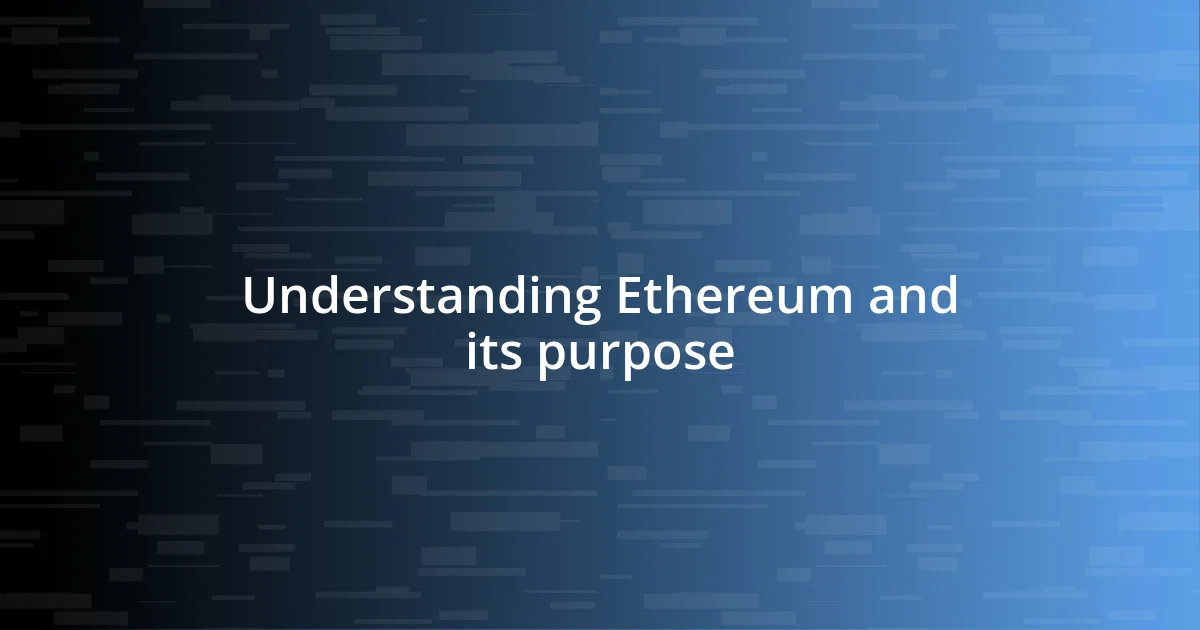
Understanding Ethereum and its purpose
Ethereum is more than just a cryptocurrency; it represents a decentralized platform that enables developers to create smart contracts and decentralized applications (dApps). I remember the first time I interacted with a dApp; the sheer potential for innovation blew my mind. It made me realize that Ethereum’s purpose goes beyond transactions—it’s about empowering individuals to take control of their digital experiences.
Have you ever pondered what a world would look like if we could eliminate intermediaries in our online interactions? Ethereum provides that vision by fostering a trustless environment where users can transact directly with one another. This capability offers an incredible sense of liberation, as it challenges the traditional systems that often limit our freedom.
The ecosystem thrives on the participation of its community, driving continuous evolution and improvement. I’m always amazed by the passionate conversations I’ve had with fellow enthusiasts about the direction Ethereum is headed. It’s not just about profits or technology; it’s about creating a more equitable digital landscape where everyone has a stake and a voice.
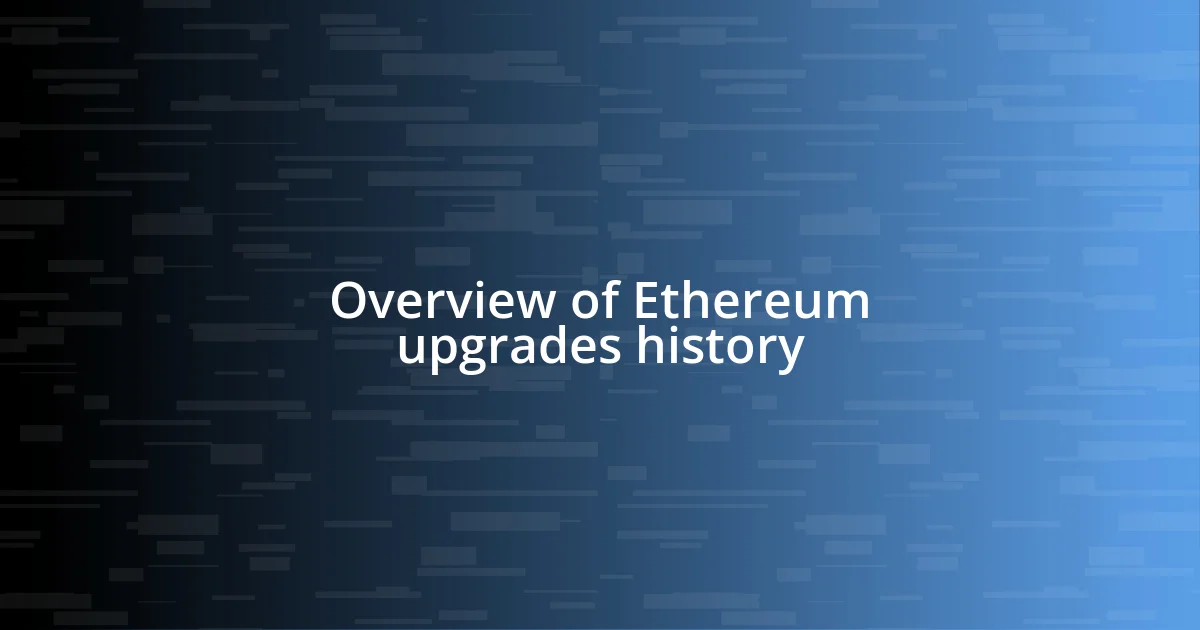
Overview of Ethereum upgrades history
Ethereum’s upgrade history is essentially a fascinating journey of innovation and adaptation, reflecting the platform’s growth in response to technological challenges and community needs. The excitement around each upgrade has always reminded me of a team working hard to refine a project, constantly seeking ways to enhance functionality and security.
- Homestead (2016): The first major upgrade, it introduced essential improvements like faster transaction processing and better error handling.
- DAO Fork (2016): A significant moment when Ethereum hard-forked to recover funds lost in the DAO incident, marking a pivotal point in governance and ethics in blockchain.
- Metropolis – Byzantium (2017): This upgrade brought privacy enhancements and the introduction of zk-SNARKs (zero-knowledge succinct non-interactive arguments of knowledge) for increased transaction confidentiality.
- Metropolis – Constantinople (2019): Aimed at improving efficiency and reducing the costs of transactions, it’s like fine-tuning a high-performance engine.
- Istanbul (2019): This upgrade further boosted interoperability and added features that improved overall network performance, increasing my confidence in Ethereum’s scalability.
- Eth 2.0 (ongoing): The transition to proof-of-stake epitomizes Ethereum’s ambition to evolve into a more sustainable and efficient platform. I see this as an exciting leap into the future of blockchain technology.
Each upgrade encapsulates community decisions and technological advancements, showcasing the resilience and adaptability that I genuinely admire in Ethereum.
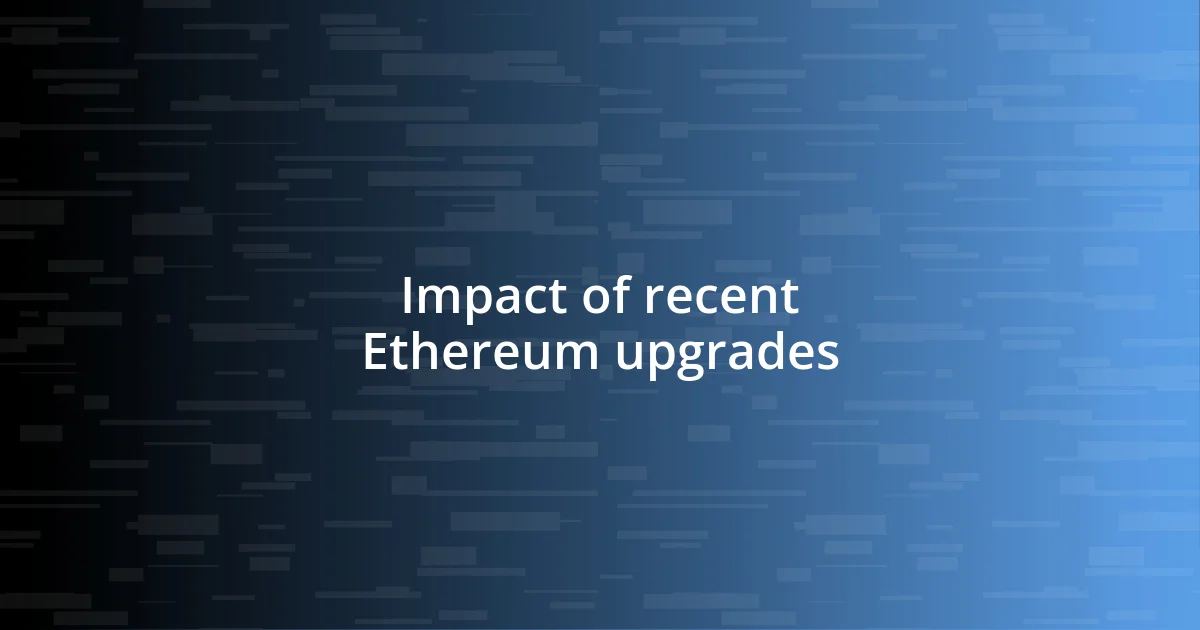
Impact of recent Ethereum upgrades
The recent upgrades to Ethereum have had a profound impact on its functionality and user experience. When I saw the transition to Eth 2.0, I felt a rush of excitement; this wasn’t just a technical improvement—it was a paradigm shift. The move to proof-of-stake has not only enhanced security but also reduced energy consumption, which is something I believe we should all be concerned about in today’s world.
In my experience, the upgrade to EIP-1559 was particularly revolutionary. This change introduced a fee structure that balances network demand and improves transaction predictability, which I found to be a game-changer. I recall the frustration of unpredictable gas fees; now, I can approach my transactions with much more confidence. It’s remarkable how a thoughtfully implemented upgrade can transform a user’s journey on the platform.
Additionally, these recent upgrades foster greater community engagement and innovation. Engaging with developers and users online helped me recognize a renewed spirit within the ecosystem. I believe this collaborative atmosphere is vital for Ethereum’s future, as it continues to evolve and embrace new possibilities. When I think of what’s next, I can’t help but feel a sense of optimism and anticipation.
| Upgrade | Key Impact |
|---|---|
| Eth 2.0 | Transition to proof-of-stake, improving sustainability and security. |
| EIP-1559 | Introduced predictable gas fees, enhancing user experience. |
| Istanbul | Boosted network performance and interoperability. |
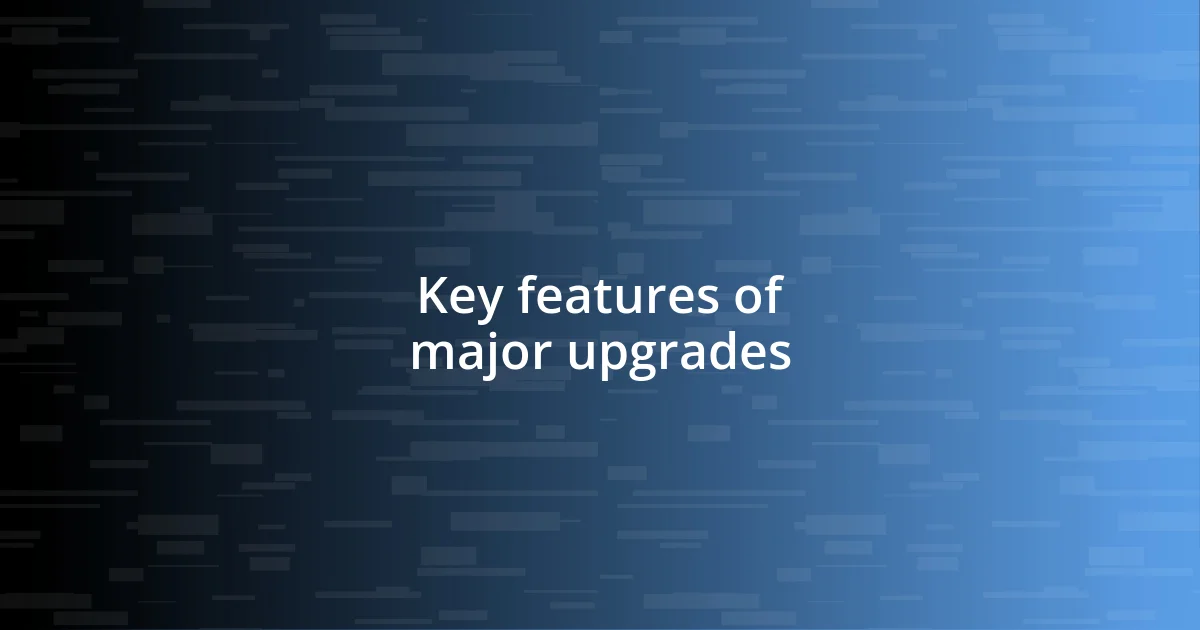
Key features of major upgrades
When it comes to the key features of major Ethereum upgrades, I always find myself reflecting on how each change reshapes the landscape. For instance, during the Metropolis – Byzantium upgrade, I was genuinely intrigued by the addition of zk-SNARKs. It felt like opening a door to a secure world where transactions could be conducted privately, almost like having a confidential conversation in a crowded room.
The impact of the Constantinople upgrade is another standout moment in my experience. It was fascinating to witness how optimizations reduced transaction costs. The feeling of finally being able to execute transactions without the inordinate fees was liberating, sparking a new wave of activity for many users, including myself. Do you remember that time when you almost hesitated to send a transaction due to high gas fees? I do, and I couldn’t be happier about that change!
Lastly, I think about the ongoing Eth 2.0 transition and how it represents a turning point not only for Ethereum but for the entire blockchain industry. Embracing proof-of-stake felt like a bold declaration of sustainability and progress. When I learned that this shift would significantly lower energy consumption, it struck a personal chord with me, inspiring a sense of responsibility in how we build the digital future. Isn’t it exciting to think about how these upgrades shape the platform’s ethos?
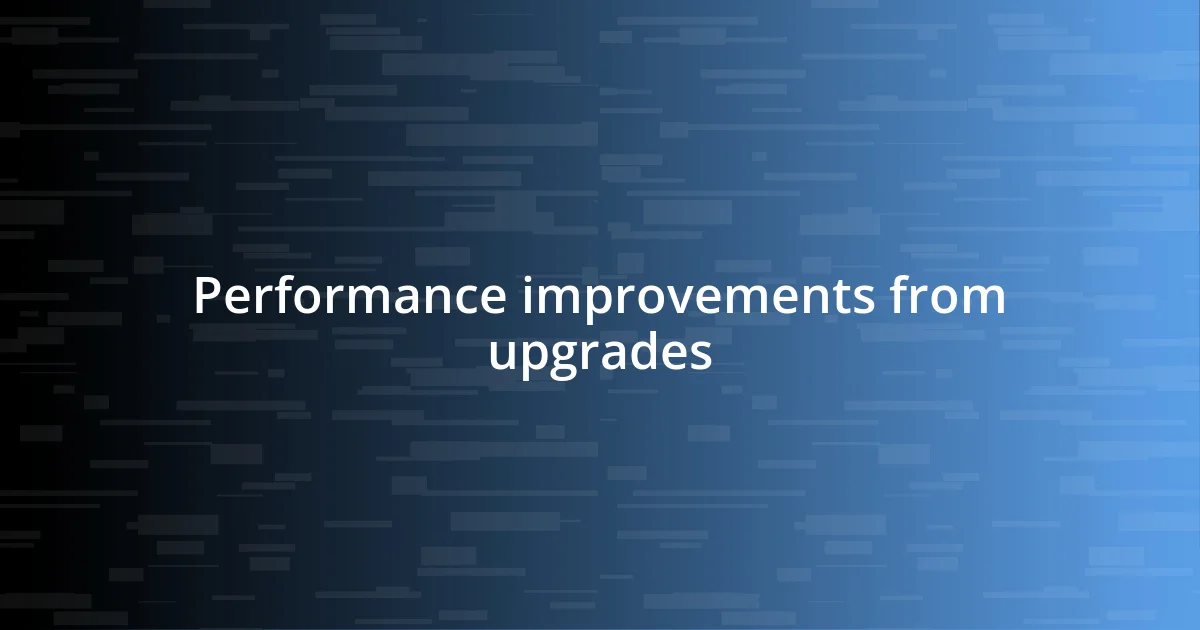
Performance improvements from upgrades
The performance improvements from Ethereum’s recent upgrades are nothing short of impressive. For instance, after the Istanbul upgrade, I noticed that the network’s efficiency soared. I could interact with decentralized applications (dApps) at speeds I had only dreamed of before. Have you ever felt that rush when everything just flows seamlessly? It’s a delightful experience that truly embodies the upgrades’ impact on user satisfaction.
Transitioning to Eth 2.0 was particularly enlightening for me. Shifting from proof-of-work to proof-of-stake felt like a breath of fresh air for the network. I remember the initial skepticism among some peers, but once the upgrade rolled out, the reduction in latency was palpable. It opened a new chapter in speed and scalability, fostering an environment where developers could innovate without being bogged down by network congestion.
What really struck me was the integration of EIP-1559 into everyday transactions. The fee structure is such a game-changer, allowing me to plan my costs effectively. Gone were the days of nail-biting uncertainty about whether I’d be hit with exorbitant gas fees mid-transaction. Instead, I found myself confidently engaging with the ecosystem, knowing exactly what to expect. Isn’t it amazing how these subtle changes boost our overall experience and trust in the platform?
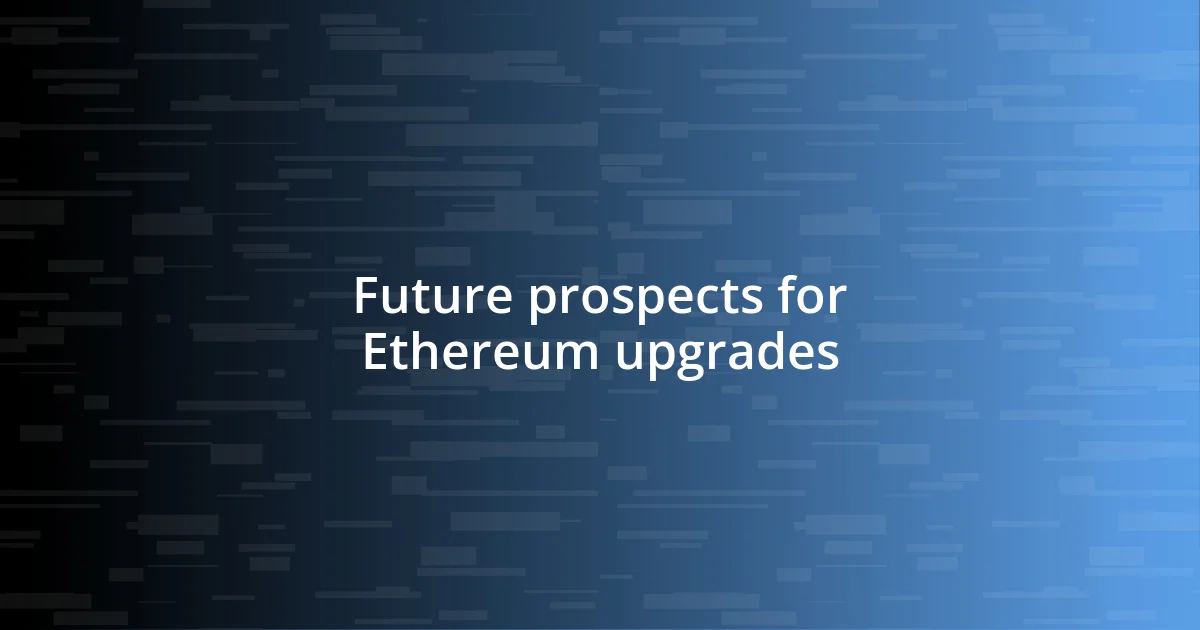
Future prospects for Ethereum upgrades
Looking ahead, the future prospects for Ethereum upgrades look remarkably promising. I often find myself daydreaming about the potential advancements in Layer 2 solutions. Imagine reducing transaction times even further and slashing fees to almost negligible levels! When I think about the applications and innovations that could flourish with such improvements, I can’t help but feel a surge of excitement.
Moreover, the anticipated implementation of sharding is one innovation I am particularly keen on. I vividly recall discussions within the community about how sharding could enhance scalability, allowing the network to handle even more transactions simultaneously. Wouldn’t that be a game-changer for developers and users alike? It’s thrilling to envision a future where Ethereum can support a vast number of dApps without compromising on performance.
Finally, I see a transformative potential in the ongoing move towards enhanced interoperability. From my perspective, the ability to communicate seamlessly with other blockchains could spark a new era of collaboration. I often think about how this interconnectedness would facilitate projects and ideas that previously felt impossible. It reminds me of when I first started exploring cross-chain capabilities—it’s like unlocking a whole new level of possibilities. Isn’t it exhilarating to think we’re just getting started?
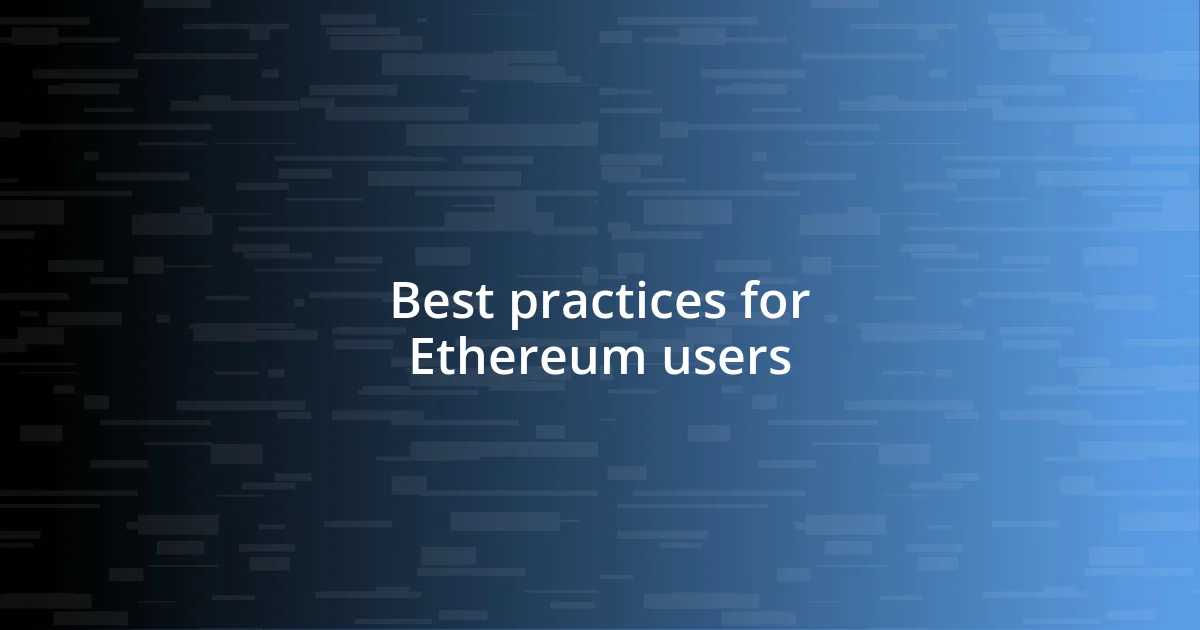
Best practices for Ethereum users
When using Ethereum, it’s crucial to keep your private keys secure. I can’t stress enough how heart-wrenching it was for a friend of mine who lost access to his wallet due to a phishing attack—one click on a misleading link, and his funds vanished. It’s a stark reminder to double-check everything, from URLs to email addresses. Have you ever wondered how one simple mistake could lead to such a huge loss? Taking the time to verify sources or using hardware wallets can be a game-changer in protecting your assets.
Another best practice I’ve embraced is staying updated on Ethereum developments. I make it a routine to follow reputable sources and community discussions. The evolution of the network is breathtaking, and sometimes, I’ve stumbled upon information that saved me from making costly mistakes. Have you ever learned about an upcoming upgrade that changed your strategy? It’s like attending a concert where every beat matters—you want to stay in sync with the rhythm of advancements to maximize your experience.
Lastly, I’ve found immense value in engaging with the community. Whether it’s participating in forums or attending meetups, sharing experiences amplifies my understanding of Ethereum’s nuances. I still remember my first meetup; I left feeling inspired by the innovation all around me. Doesn’t it feel fantastic to be part of a collective movement? Connecting with others not only enriches my knowledge but also builds a sense of camaraderie I cherish deeply within this ecosystem.












